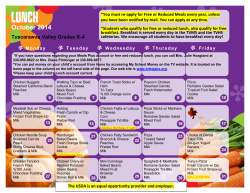
Goats- large and small and their Udders
Goats- large and small and their Udders Debbie Nicolaides Wild River Goats Imbil, QLD, 0487 963076 Please use this article as a guide, this is what works best for me. Anatomy A goats udder is divided into two quarters, each quarter ending in a teat outlet. Each quarter is separate from the other and the whole udder is held in place by suspensory ligaments. It is important to have good front and rear udder attachmentswhere the udder is attached to the body. With Dairy goats it is a requirement that the does have only 2 teats with one hole in each teat. Teat deformities are disqualified. Milk constituents are delivered by the blood stream into the secretory tissue of the udder (the alveoli). Milk then drains into the central udder cistern above the teat. A valve/sphincter temporarily closes off the udder cistern from the teats. Squeezing the teat thus pushes milk down the teat and out thru the teat opening at the end of the teat. Immediately after kidding, does need to be milked twice a day, when the quantity of milk decreases as the lactation progresses , she can be milked once a day. Udder Preparation The udder of the goat is more sensitive and of a softer texture than a cow, and undue force can cause a number of issues. First kidders have to be ”broken in” to milking. Lots of patience, talking to her, very gentle. Remember teats will lengthen as the lactation progresses. Milking should be done as gently as possible, you should not tug the udder and avoid stripping down movements. Rough handling can cause cracking of the delicate internal lining of the teat, and allow bacteria to enter. Keep fingernails short, make sure hands are clean and dry. If a goats teats are washed prior to milking, (the water can contain a little mild detergent and disinfectant), then the teats must be dried with a disposable paper towel-a fresh towel for each goat. I use “homebrand disposable baby wipes”, 1-2 depending on how dirty the teats are. Milking Stand Getting ready to Milk If milking takes too long, the goat will start to fidget- feed helps keep her calm. You can milk from either side or from behind. The first couple of squirts of milk are discarded, my dogs wait for this. Milking the goat Place four fingers on one side of the teat and the thumb on the other. Apply pressure with the 1st finger and thumb, in order to hold the milk in the teat, ( stops backflow), and then apply pressure with the 2nd, 3rd, and 4th fingers in turn, in order to force the milk down. The pressure should be firm but gentle. You will learn to judge for yourself how much pressure to use. Start doing one teat at a time, then progress to 2 teats when you are feeling proficient. Do not place the hand too far up the top of the teat, you can damage the udder/teat. A change in colour in the milk can indicate a broken blood vessel in the udder ( not unusual for large producing dairy goats), or mastitis. Dispose of this milk. Another way of describing the milking action. The milker should grasp the teat gently but firmly. Allow the teat to fill with milk , then close off the top of the teat with the thumb and forefinger, squeeze the teat with the rest of the fingers, with a rolling motion continuing down the teat, allowing the teat to refill each time. You will get faster with practice. The hole at the end of the teat can take 15-30 mins to shrink back t o its normal state. The teats will need to be dipped in disinfectant – like betadine or sprayed with a purpose made disinfectant. Some people make their own. Because there is a greater risk of introducing bacteria and dirt in the orifice as it does take time for the teat hole to shrink back. This disinfectant helps stop mastitis developing. Preparing the milk for household use. Milk needs to be strained and chilled as soon as possible, I personally use purpose made, disposable paper milk filters (purchased from “Caprine Goat Supply in USA, they work perfectly, far better then paper towels and cloth). They also sell a special funnel for the filter to go into. The paper filters lock in with a stainless ring. I also purchase new plastic one litre milk bottles from “ Gympie Packaging” – able to be frozen when I get excess milk. Glass is good, but milkstone develops on the inside of the bottle, and glass ca not be frozen. Everything else I use is stainless steel, buckets jugs ,funnels, strainers, mesh drying racks. I do not use cloths, only disposable paper towels, baby wipes ,and disposable filter papers. Once strained, milk is placed in freezer to ”chill”. Needs to get down to 4-6 degrees Celsius in 4 hrs. Milk can be pasteurised if you prefer- this is a heating process. Heat the milk until milk reaches 82 degrees C then cool and chill very fast. Washing Up 1. thoroughly rinse with cool-warm water. Failure to do this, results in the build up of milk stone. 2. Scrub with boiling water, with or without detergent. Can be sanitised with a dairy cleanser- milk stone solvent. 3. Rinse with clean boiling water. 4. Milking utensils, i.e. buckets etc, should be turned upside down in a dry clean place, preferably on a metal rack, and left to dry. Never dry with a cloth. By keeping milking utensils properly clean, helps keep bacteria under control and stops milk from tainting. I herd record all my goats (saanens), they have won awards for highest % butterfat in Qld., and milk awards for high production and high butterfat. They produce 4-6 litres a day. One saanen I had , used to produce 8 litres a day. Most saanens will keep milking indefinitely, they do not need to be kidded each year. Most miniature bred does produce 1-2 litres a day. The stainless steel strainers _small cost $15 ea USA Paper filters are $8 box of 200 USA plus post Very Simple Curd Cheese Quantity of goats milk – strained Junket tablets – available from IGA supermarkets Follow recipe on junket packet, but double the amount of junket required for the amount of milk Allow to set overnight 12-24 hours- at room temp. Cut with a clean knife. Strain the curds and whey, the whey will strain thru a clean cloth. Usually strain overnight in the fridge. Place the cloth in a colander and pour the curds and whey in, with a large pan under the colander to catch the whey. At the same time add salt, usually 2-3tsps depending on amount or cheese and taste. Salt is a preservative and will stop the cheese going rancid. Also at this time , you can mix in extras such as Green peppercorns Capsicums Chives Once most of the curds have strained thru the cloth ,the excess whey can be squeezed out by compressing the curd in the cloth. Refrigerate what is left over after sampling. Fruit goat`s milk ice cream 240 ml fruit puree, ideally made from fresh fruit 240ml fresh goat`s milk 140 ml goat`s milk cream 150 gm caster sugar 15 gm gelatine 1 teaspoon lemon juice Dissolve the gelatine with three tablespoons of water in a bowl over a saucepan of hot water. Add it to the fruit puree and stir well. Beat the milk and sugar, gradually adding the fruit puree and gelatine, followed by the lemon juice. Gently fold in the cream, then freeze for half an hour in the freezing compartment. After this time, remove and stir well, to prevent ice crystals forming. Replace into freezer until firm.
© Copyright 2025









